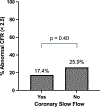Visual Estimates of Coronary Slow Flow Are Not Associated With Invasive Wire-Based Diagnoses of Coronary Microvascular Dysfunction
- PMID: 38583174
- PMCID: PMC11187652
- DOI: 10.1161/CIRCINTERVENTIONS.123.013902
Visual Estimates of Coronary Slow Flow Are Not Associated With Invasive Wire-Based Diagnoses of Coronary Microvascular Dysfunction
Abstract
Background: Coronary slow flow (CSF) by invasive coronary angiography is frequently understood to be an indicator of coronary microvascular dysfunction (CMD) in patients with ischemia with nonobstructive coronary arteries. However, the relationship between visual estimates of CSF and quantitative wire-based invasive diagnosis of CMD is uncertain.
Methods: We prospectively enrolled adults aged ≥18 years with stable ischemic heart disease who were referred for invasive coronary angiography. Individuals with ≥50% epicardial coronary artery stenosis were excluded. Invasive coronary angiography was reviewed for CSF, defined as ≥3 cardiac cycles to opacify distal vessels with contrast. Coronary function testing was performed in the left anterior descending coronary artery using bolus coronary thermodilution techniques to measure coronary flow reserve (CFR) and the index of microcirculatory resistance (IMR). Invasively determined CMD was defined as abnormal CFR (<2.5), abnormal IMR (≥25), or both.
Results: Among 104 participants, the median age was 61.5 years and 79% were female. The median CFR was 3.6 (interquartile range, 2.5-4.7) and the median IMR was 21 (interquartile range, 13.3-28.0). Overall, 24.0% of participants had abnormal CFR, 34.6% had abnormal IMR, and 48.1% had a final diagnosis of invasively determined CMD. CSF was present in 23 participants (22.1%). The proportions of patients with CMD (56.5% versus 45.7%; P=0.36), abnormal CFR (17.4% versus 25.9%; P=0.40), and abnormal IMR (43.5% versus 32.1%; P=0.31) were not different in patients with versus without CSF.
Conclusions: Among patients with ischemia with nonobstructive coronary artery, CSF was not associated with abnormal CFR, IMR, or either abnormal CFR or IMR. CSF is not a reliable angiographic surrogate of abnormal CFR or IMR as determined by invasive, wire-based physiology testing.
Registration: URL: https://www.clinicaltrials.gov; Unique identifier: NCT03537586.
Keywords: coronary angiography; coronary circulation; ischemia; microvascular angina; thermodilution.
Conflict of interest statement
Figures






References
-
- Shaw LJ, Shaw RE, Merz CN, Brindis RG, Klein LW, Nallamothu B, Douglas PS, Krone RJ, McKay CR, Block PC, et al. Impact of ethnicity and gender differences on angiographic coronary artery disease prevalence and in-hospital mortality in the American College of Cardiology-National Cardiovascular Data Registry. Circulation. 2008;117:1787–1801. doi: 10.1161/CIRCULATIONAHA.107.726562 - DOI - PubMed
-
- Jespersen L, Hvelplund A, Abildstrom SZ, Pedersen F, Galatius S, Madsen JK, Jorgensen E, Kelbaek H, Prescott E. Stable angina pectoris with no obstructive coronary artery disease is associated with increased risks of major adverse cardiovascular events. Eur Heart J. 2012;33:734–744. doi: 10.1093/eurheartj/ehr331 - DOI - PubMed
MeSH terms
Associated data
Grants and funding
LinkOut - more resources
Full Text Sources
Medical

